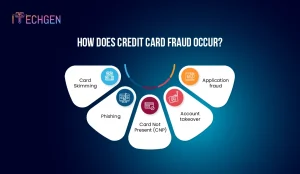
Credit card fraud is an alarming threat to both businesses and their clients. The increasing number of online transactions has opened doors for cyber criminals to exploit payment gateways. While many credit card firms take mandatory measures to stop fraud, they still need to seek advanced technologies to secure their clients. One of these technologies is credit card fraud detection with AI.
Several studies show that in today’s high-tech world, traditional fraud detection systems are facing difficulty coping with cyber crimes and data breaches. That’s why credit card fraud detection with AI and ML is setting new standards. What has made this technology a need of the hour is the evolution of fraud itself. Unlike traditional rule-based detection systems, AI systems are not limited to flagging suspicious activities. They’re a complete package consisting of threat detection, adaptive learning, and continuous improvement.
In this post, let’s understand how AI can protect users and businesses from fraudulent activities. Also, we’ll explore some of the common credit card frauds and practices to prevent them.
Businesses and financial institutions have always had difficulties with detecting credit card fraud. Traditional rule-based systems generally use predefined to identify fraudulent activities, but they can’t keep up with emerging, more sophisticated threats. As ill-intenders are becoming more skilled with their approach, advanced credit card fraud detection with AI is here to save the day.
With the surge in ML, fraud detection has become easier than before. Machine learning models analyze extensive amounts of transaction data in real time. It looks for patterns and behaviors that may raise suspicion. With ML, systems don’t simply depend on static rules. Instead, they actively learn from new datasets to improve their ability to detect fraud as they appear.
This continuous learning process enables AI systems to adapt to emerging fraud activities, making them more efficient at identifying hidden threats. Unlike traditional systems, these models offer better outcomes with fewer false positives. As fraud patterns are becoming more complicated, credit card fraud detection with AI offers businesses a more resilient and reliable way to protect customers and financial facilities.
A report by FTC reveals that credit cards topped the list of identity thefts, bringing in 416,582 in 2023. Based on data and the prevailing scenario, this number may reach around 919,467 by 2030. The average loss per fraud was around £400.
Some Credit Card Frauds include:

Image like this but use the below pointers

| Parameter | Rule-Based Model | Machine Learning Model |
| Data Sources | Depend on transaction logs, rules & predefined thresholds | Rely on transaction logs, historical data, behavioral patterns & features extracted from transactions |
| Detection Approach | Rule-based detection with predefined patterns | Data-driven approach using pattern recognition, anomaly detection, clustering & classification |
| Complexity | Relatively simple | Can handle complex, nonlinear relationships |
| Adaptability | Poor adaptability | Can adapt to evolving fraud patterns |
| Accuracy | Limited accuracy | Higher accuracy with continuous learning |
| Scalability | Limited scalability | Highly scalable to large datasets & real-time analysis |
| Detection Speed | Delays in real-time transaction processing | Faster real-time transaction processing |
| False Positive Rate | Rigid rules result in higher false positives | Advanced algorithms & continuous learning reduce false positives |
| Interpretability | Easily interpretable | May lack interpretability, but can be made easier to explain |
| Cost | Initially low, but increasing number of false positives and manual reviews may increase the cost | Higher initial investment but cost-saving through automation and enhanced detection |
| Response to New Fraud Patterns | Requires manual updates for new fraud cases | Can automatically adapt to new fraud patterns through continuous learning |
Credit card fraud detection with AI and ML provides several benefits over rule-based models. Advanced systems use comprehensive transactional data, user behavior, and state-of-the-art algorithms to deliver exceptional accuracy and efficiency in results.
Here’s how ML prevents credit card fraud:
Modern systems comprise powerful ML algorithms that analyze extensive datasets to pinpoint suspicious patterns and anomalies in transaction behavior. These models are designed to easily differentiate between authorized and unauthorized transactions with a high level of accuracy, further reducing the chances of generating false positives (authorized transactions flagged as suspicious) and unauthorized transactions (undetected unauthorized transactions).
Unlike rule-based methods, AI models continuously learn from fresh datasets and adapt to emerging fraud tactics. It tracks advanced attempts for phishing, identity theft, or account takeover. It also helps credit card companies to stay ten steps ahead of cybercriminals by identifying and tackling sophisticated fraudulent activities in real time.
Traditional systems lack adaptability, and thus, do not detect fraudulent activities that involve multiple variables or complex patterns. In contrast, ML-based systems excel at identifying high-level fraud schemes by uncovering concealed patterns and non-linear relationships. The technology leverages neural networks and decision trees to help engineers detect suspicious activities that might go unnoticed with manual or traditional methods.
With ML-based systems, businesses can automate most of their fraud detection processes, reducing human involvement. The modern detection system is designed to flag potential or suspicious transactions in real time and quickly automate the investigation process. It allows analysts to focus on high-priority cases and enhance overall operational efficiency and response time.
What makes ML-based, modern detection systems well-recognized is their ability to monitor transactions in real time and send alerts whenever needed. It continuously analyzes data and quickly flags suspicious activities as soon as they occur by sending alerts to fraud prevention teams. This proactive approach helps prevent fraudulent transactions before they are completed, drastically reducing financial losses.
In today’s rapidly growing digitalization, keeping yourself aware of the evolving fraud tactics is mandatory. Here are some key signals that indicate it’s time to integrate AI in credit card fraud detection system:
Manual fraud detection becomes difficult when your business experiences unusually high daily transactions. In such cases, ML-powered systems work wonders. These detection systems process extensive data in real time and identify suspicious patterns within authorization transactions. This further ensures faster and more efficient fraud detection.
Establishing new operations or navigating new marketplaces may expose your credit card company to unforeseen fraud patterns. AI-powered systems quickly adapt to this dynamic infrastructure and use historical data to efficiently detect modern fraud patterns. This adaptability makes AI-powered fraud detection an invaluable tool for companies exploring new market opportunities.
Transactions related to high-risk cross-border activities are highly susceptible to fraud. To combat that, systems equipped with AI-based detection technology are designed to effectively analyze a variety of information and identify suspicious behavior, irregularities, and geographical inconsistencies. These algorithms effectively flag potential risks, helping businesses secure international transactions and protect confidential payment data.
Integrating third-party payment gateways can boost your business operations to a great extent. However, this also increases the chances of fraudulent activities to occur. ML-based systems offer powerful monitoring features across integrated networks, promptly identifying and neutralizing the source of fraud. This helps maintain trust and security in interconnected payment ecosystems.
Undoubtedly, today’s advanced technology like credit card fraud detection with AI is a foolproof way to enhance security in various financial facilities. It is a robust weapon that scrutinizes immense amounts of data in real-time and spots ever-evolving fraud patterns. This technology is not just limited to transactions, it is a powerful asset to fight against online scams, identity theft, and more. Through AI, businesses and customers can now confidently navigate the digital payment landscape by using data-driven insights and sophisticated algorithms. They know that they are well-protected against any fraudulent activities.

iTechGen is a leading company that delivers top-class AI development services across the world. We have the skills to provide AI solutions to various industries, including FinTech, Healthcare, eCommerce, and Logistics, using a tailored approach that fits your needs. Reach out to us today for expert machine-learning consulting services.

Pankaj Arora is the Founder & CEO of iTechGen, a visionary leader with a deep passion for AI and technology. With extensive industry experience, he shares expert insights through his blogs, helping businesses harness the power of AI to drive innovation and success. Committed to delivering customer-first solutions, Pankaj emphasizes quality and real-world impact in all his endeavors. When not leading iTechGen, he explores emerging technologies and inspires others with his thought leadership. Follow his blogs for actionable strategies to accelerate your digital transformation and business growth.
View More About Pankaj Arora